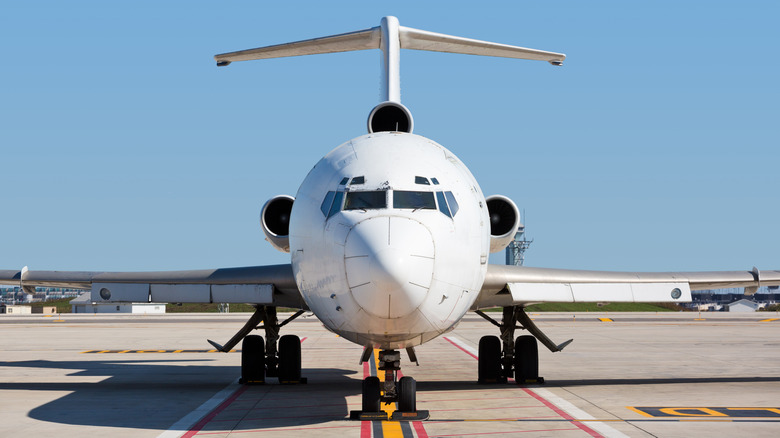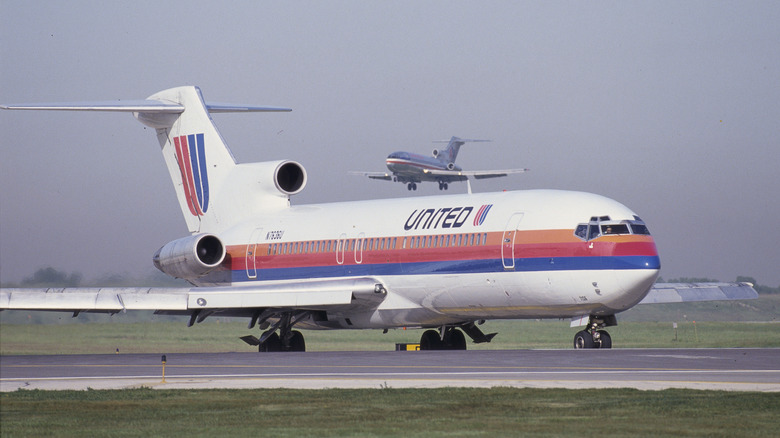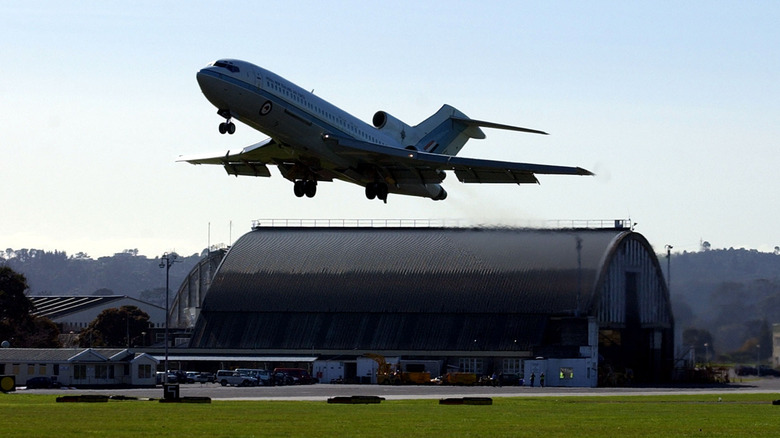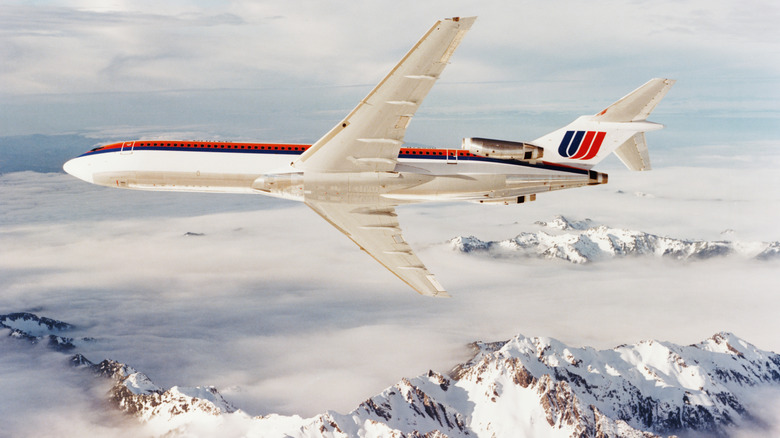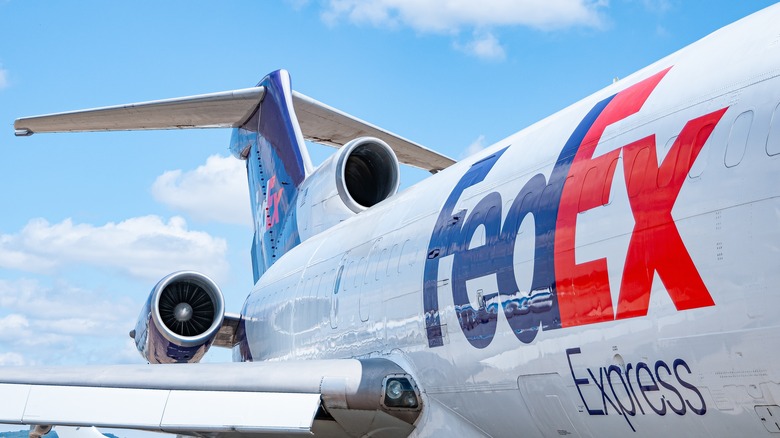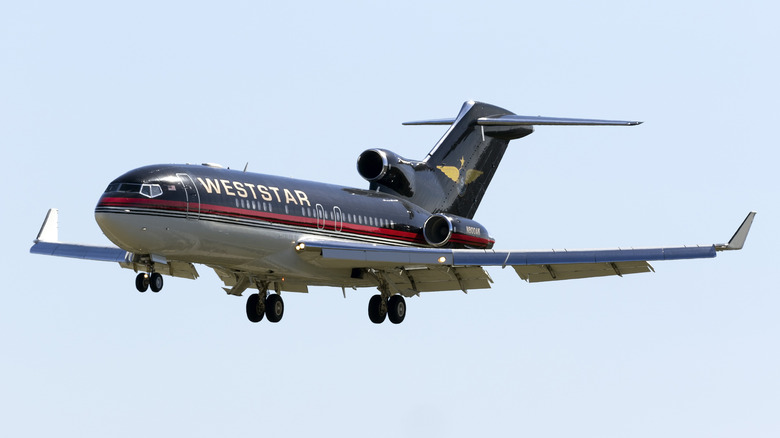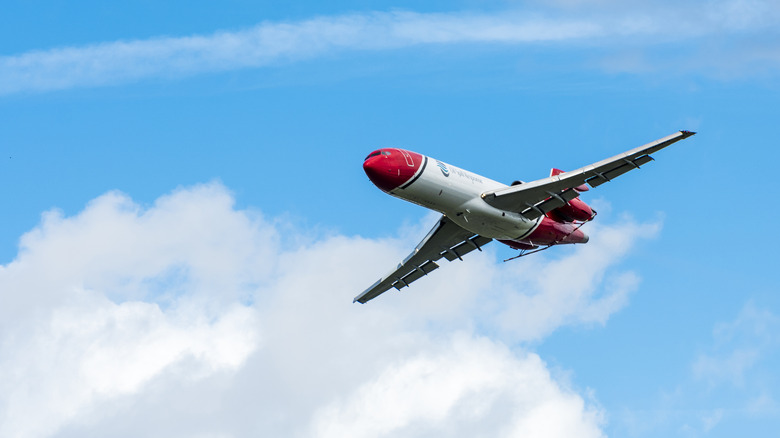Everything To Know About The Boeing 727 Passenger Jet
Boeing is among the most well-known aerospace companies in the world and has built a wide assortment of different aircraft over the past century. However, it's only produced one plane with exactly three jet engines in its long history: the Boeing 727. As Boeing's only commercial aircraft with three jet engines — known in the industry as a trijet — the 727 holds a unique place in the company's history, as well as in the history of commercial aviation.
As one of Boeing's most iconic and innovative aircraft, the 727 was designed in the 1960s to meet the growing demands of commercial airlines during a time of rapid expansion. With its distinctive T-tail and three-engine configuration, the jet was perfect for short to medium-haul flights, offering versatility, efficiency, and top notch performance that quickly made it a popular option for airlines and one of the most commonplace commercial jets in the skies.
Despite being one of the biggest trijets ever made, the Boeing 727 was capable of operating from shorter runways around 4,500 feet long, which allowed airlines to grow their markets by flying into and out of smaller cities. The aircraft helped set the standard for what travelers expected from jet travel and was a key vehicle for airlines for over two decades. Even after Boeing ceased production of the trijet in favor of more modern aircraft, the 727 is still used today in ways that are both practical and downright fascinating. Here is everything you need to know about the Boeing 727 passenger jet.
Boeing designed the 727 to cater to a wide range of needs
As commercial flight became more mainstream and expanded to larger customer bases across more parts of the globe, major airline corporations became interested in an aircraft that could hold many passengers but still utilize smaller airports. Larger commercial jets at the time were unable to use many of the regional airports, because of the amount of runway that the aircraft needed. Furthermore, an ability to bring commercial jets to small airports would allow airlines to create additional, shorter routes as air travel became more commonplace.
In the late 1950s, three major airlines — United Airlines, Eastern Air Lines, and American Airlines — collectively requested Boeing to design the aircraft that would become the 727, though each company had their own reasons. United sought an aircraft for high-altitude airports and Eastern required one suitable for overwater routes, while American Airlines was interested in a fuel-efficient twin-engine jet. Boeing's engineers eventually concluded that a three-engine configuration would be necessary to meet the needs of the three corporations — while it wasn't a twin engine, it would still have the fuel efficiency that was important to American Airlines. With three engines, Boeing would be able to manufacture a jet that could handle various operating conditions, while also able to take off from and land on shorter runways.
The original 727 prototype went straight to work
Boeing began development of the 727 in 1959, building off elements already in use with the manufacturer's 707, which was Boeing's first commercial jetliner and which had been in operation since 1957.
The first 727 was used for testing the designs that were necessary to meet the needs of the airlines, including the high-lift wings that allowed it to take off from shorter runways. It was also engineered with the ability to use various features, such as built-in air-stairs for passengers to board and disembark without ground equipment — this allowed the jets to operate from smaller airports lacking the infrastructure designed for bigger planes.
Four years after its development commenced, the maiden flight of the 727 took place on February 9, 1963. Unlike many aircraft prototypes, the original 727 that was built and tested actually went straight into service with United Airlines, becoming part of their regular fleet for nearly three decades. It wasn't until Boeing did the same with the 777 in the 1990s that the manufacturer ceased the practice of a dedicated flight test prototype not intended for sale. Soon after the trijet began flying for United Airlines, American and Eastern added the 727 to their respective fleets as well.
The 727 was a huge success for Boeing
Boeing continued to produce the 727 for two decades, and it proved to be one of the most successful aircraft in the history of commercial aviation. Between 1963 and 1984, there were 1,832 units of the trijet manufactured, making it one of the most widely used commercial aircraft of its day. The 727 became the first commercial jet to sell more than 1,000 units. In fact, the Boeing 727 held the record for the best-selling jet airliner until that record was broken in the early 1990s by its successor, the Boeing 737.
The reasons behind the success of the 727 are easy to see and directly correlate to why the trijet was developed in the first place. Its versatility and ability to operate at smaller airports, and on short to medium-length routes, made it a popular choice for many airlines to use in both domestic and international flights. Furthermore, until surpassed by newer more efficient aircraft, the 727's fuel efficiency — a key concern for airlines overhead costs — also made it a desirable aircraft to keep in the fleet.
The 727-200 is the most common variant of the aircraft
The original run of 727s was the 727-100 model. After just a few years, due to a demand to fit in even more passengers per flight, Boeing produced the 727-200, which is 20 feet longer and can hold a few dozen more seats. The Advanced 727-200 soon followed, which included structural improvements and increased fuel capacity to support the additional weight, helping to extend its range. This model became Boeing's primary 727 variant for the rest of its production run.
Cargo companies, including FedEx and UPS, also became fans of the 727 for its cost-saving fuel efficiency and ability to land at smaller airports. One freighter variant, the 727-200F, was dedicated for cargo transport and featured a large side cargo door. Another model — the 727-100QF — was used by UPS and employed special Rolls-Royce Tay turbofan engines, which were quieter for flying at night.
Convertible versions of the 727 were also developed to change back and forth between passenger and cargo configurations. This included the Boeing 727-100QC, or "Quick Change" model, that could make the transformation in just 30 minutes. Other variants include the Boeing C-22A and Boeing C-22B, which were operated by the United States Air Force and helped to transport troops.
The 727 has a unique third engine and other impressive features
Of course, the third engine is what really stands out on the 727, but it has other impressive specs as well. To keep the plane balanced, the third of its three Pratt & Whitney JT8D engines sits atop the rear center of the fuselage in a T-tail configuration. Together, the three can collectively produce up to 46,500 lbs of thrust, with the third engine not just contributing to the 727's fuel efficiency but also providing much-needed redundancy for high-altitude and overwater trips.
The 727-100 model is approximately 133 feet long, while the 727-200 is about 153 feet long, with both variants sporting the same 34-foot height and 108-foot wingspan. The maximum takeoff weight for the once commonly-flown 727-200 is 194,800 lbs and its fuel capacity is 77,260 lbs, with the latter making the plane especially efficient for medium-haul routes.
The aircraft's top speed is 485 knots, or about 560 mph, while its normal cruise speed is around 465 knots. The rate of climb for the 727-200 is 2,380 feet per minute, which is what helped the trijet to take off from shorter runways and made it so useful for airlines and freight companies.
The 727 is still in service today — in some interesting ways
While the Boeing 727 was a popular choice among commercial and freight airlines for over 20 years, Boeing officially discontinued production of the plane in 1984, in favor of quieter, more fuel efficient jets with lower operational costs. However, just because Boeing stopped making new 727s doesn't mean that the nearly 1,900 already built stopped flying. The Boeing 727 flew its last commercial flight in January 2019 for Iran Aseman Airlines — the plane was almost 40 years old when it made the trip. FedEx and UPS no longer use the Boeing 727 in their fleets, with the last 727 carrying cargo for FedEx in 2013.
Other 727s are still around serving in other capacities. The U.K. firm Oil Spill Response employs two 727s to help clean up oil spills by dispersing oil-thinning fluids over them. Another unique 727 is "Air Horse One," which is exactly what it sounds like — a luxurious private transportation jet used for equestrian sport horses. The plane includes premier horse care staff and amenities. So, while the 727 has long since been discontinued, if you look up in the sky you might still see a few trijets to this day. One may even be carrying horses in first class.
